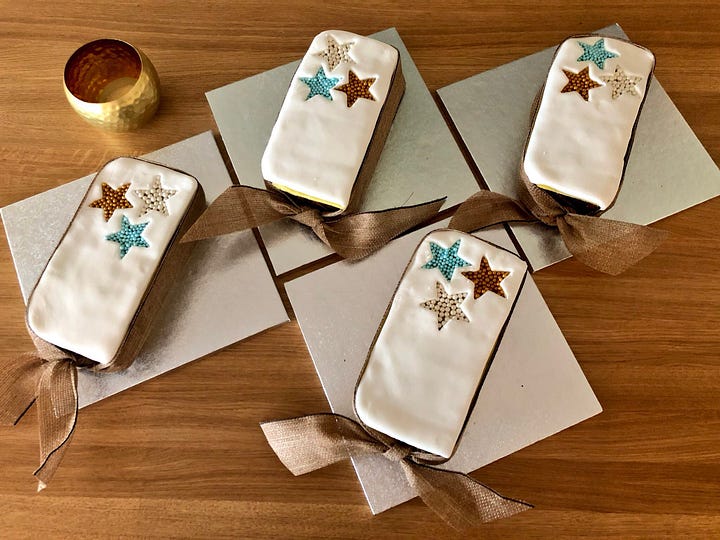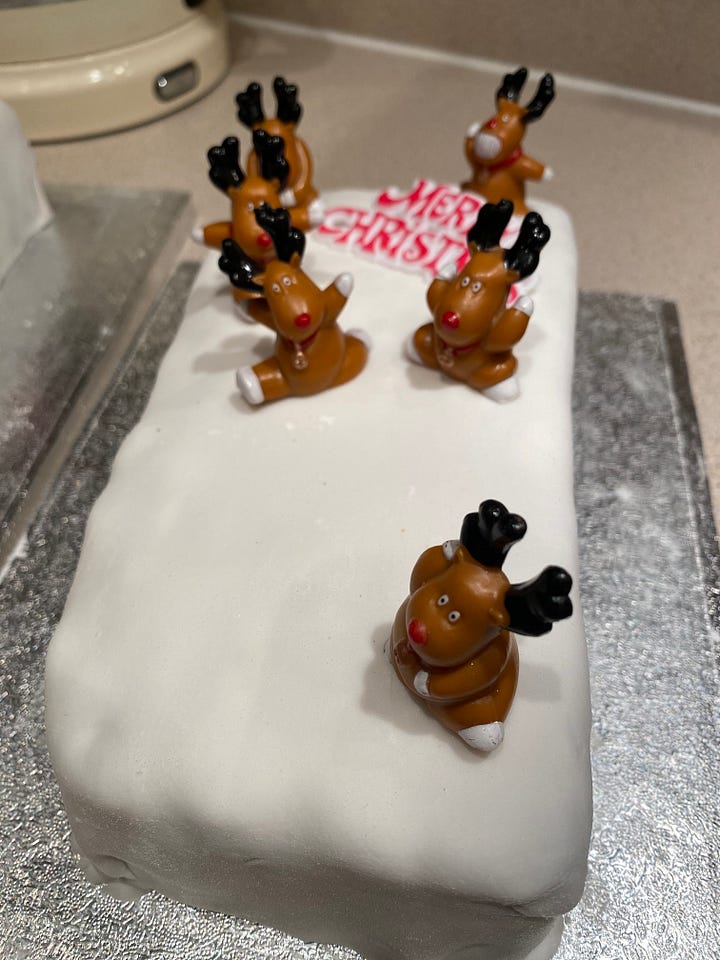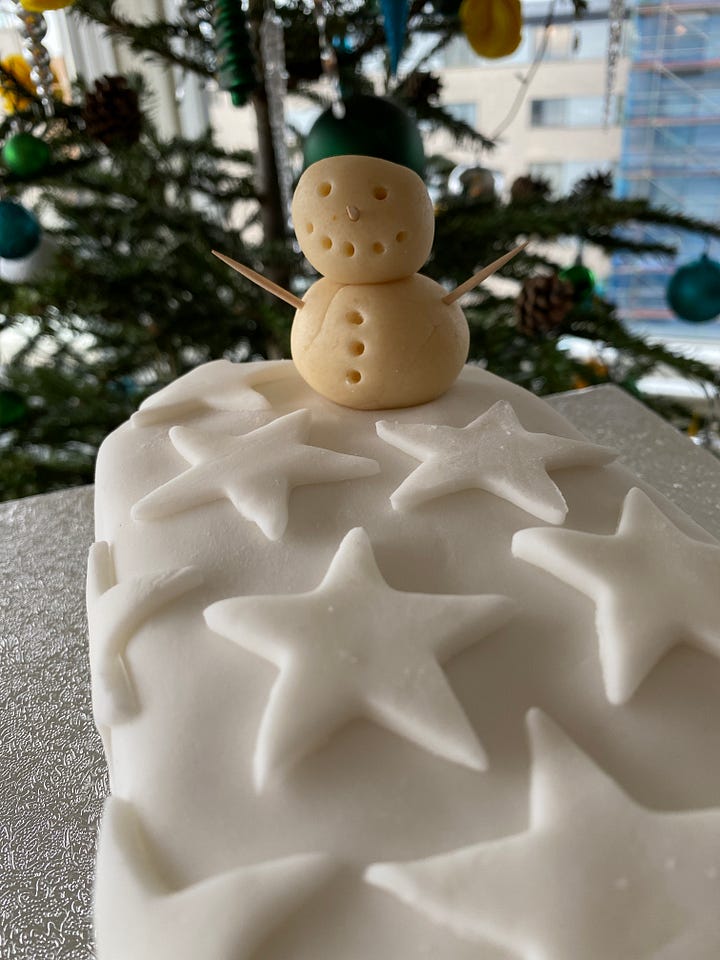Baking Christmas Cakes in October: Tradition, Tips, and a Head Start on the Festivities!
Let’s talk Christmas cakes… 🎄🍰
As the days grow shorter and the chill of autumn sets in, I find myself starting to plan for Christmas. For me, the start of the festive planning is baking my Christmas cakes in October. You might think it’s a bit early, but the secret is: the earlier you make it, the better it tastes! And there’s something so special about getting a head start on the festivities while the rest of the world is still focused on pumpkins and falling leaves.
Carrying on a Family Tradition
Christmas cake-making has always been a tradition in my family and one I remember making with my grandfather as a child. Bampy was the cake maker of the family, and his fruitcake was legendary—rich, dark, and packed with flavour. Since he passed, I’ve taken up the mantle, and it’s another way to stay connected to him and honour his memory as I do with my knitting. Each year, I make these cakes not just for myself, but for friends and family, continuing the family tradition.
Why I Bake My Christmas Cakes in October
Baking Christmas cakes in October has always been my way of giving the cakes time to mature. For those unfamiliar with this tradition, letting the cake rest for a couple of months allows the rich mix of fruits, spices, and liquid to meld together, deepening the flavours. It’s like letting the cake take its time to become something truly magical. By the time December rolls around, it’s moist, fragrant, and full of that comforting, festive taste we all love.
But I don’t do things exactly as my grandfather did—I’ve made my own little tweaks to the recipe. Rather than soaking my fruit in brandy, I use freshly squeezed orange juice and spiced rum. 🍊🥃 The zesty citrus and warming spice give the cake a unique twist, while still capturing that traditional Christmas spirit. The orange juice makes the cake wonderfully fresh, and the spiced rum adds a cosy depth of flavour that just feels perfect for the season.
Baking Weekend Rituals: Cake in the Oven, Knitting in Hand
I like to reserve a Saturday or Sunday for the annual baking ritual. With the fruit soaked, the spices measured, and the oven preheating, the house fills with the warm, comforting smells of Christmas. My cakes bake for about four hours, so while they’re in the oven, I love to settle in with my knitting needles. There’s something so meditative about spending those hours knitting away as the cake bakes, knowing that by the end of the afternoon, the house will be filled with the sweet, spicy aroma of Christmas.
This is my little October tradition—baking and knitting side by side, getting ready for the holidays in the most relaxing way possible. There’s nothing quite like sitting on the sofa, needles clicking away, while that cake slowly bakes to perfection in the oven.
Decorating: A Creative Challenge Every Year
One of my favourite parts of this tradition is decorating the cakes. Each year, I try to come up with a different design—it’s become a bit of a creative challenge! I like to mix the decorating up and think of new ways to make each cake feel unique. Some years I’ve used cake toppers, others its stars… I still don’t know what this years will be yet!




Coming up with fresh designs each year keeps the process exciting, and it’s always fun to surprise friends and family with something new.
Tips for Making the Perfect Christmas Cake
If you’re thinking about starting your Christmas cake early this year, here are a few tips from my kitchen to yours:
1. **Soaking the Fruit**: Like I mentioned, I soak my dried fruits (a mix of raisins, sultanas, currants, and glacé cherries) in a combination of freshly squeezed orange juice and spiced rum. Let the fruit sit for at least 24 hours to soak up all the flavours before you start baking.
2. **Spices Are Key**: A good Christmas cake is all about the spices. I use a mix of cinnamon, nutmeg, cloves, and ginger to give the cake that warm, festive flavour. Don’t be afraid to adjust the spices to your liking.
3. **Bake Slowly**: Christmas cakes need a long, slow bake. I usually bake mine for around four hours at a low temperature - usually around 130 degrees centigrade. This ensures the cake cooks evenly and stays moist, without burning around the edges.
4. **Feed the Cake**: After the cake has baked and cooled, I wrap it in parchment paper and foil. Over the weeks leading up to Christmas, I’ll “feed” the cake by drizzling it with a little more spiced rum every couple of weeks. This keeps the cake moist and intensifies the flavour.
Bringing Knitting and Baking Together
There’s something truly *hygge* about knitting while the cakes bake. It’s one of those simple pleasures that makes autumn weekends feel so cosy and productive. And if you’re a crafter like me, I encourage you to use this time to work on holiday knitting or crochet projects. Whether you’re making handmade gifts or just indulging in a little self-care crafting, it’s the perfect way to enjoy the quiet, creative moments before the Christmas rush.
---
So What About You?
Do you bake your Christmas cake early too, or do you prefer a different approach? I’d love to hear about your cake-making traditions, tips, or decorating ideas. Feel free to share your tips and techniques in the comments—I’m always looking for new ways to tweak my own cakes!
Happy baking and knitting, and here’s to a cosy, festive October! 🎄✨




Hey Martyn, Regarding the cake decor, how about a getting tree decor from the Garden Centre [or wherever] and then it serves as an added gift for the tree afterwards. There are so many cute trinkets little hedgehogs, robins, you name it. Just a thought.
I follow the Christmas cake recipe from my Domestic Science recipe book (it’s covered in my bedroom wallpaper ~ remember when your first week’s homework was to cover your exercise books and text books?) I had costed the ingredients…..milk was 5p per pint. It says to add the flour and eggs “alternatively”. Takes me back to the old me of 1972.